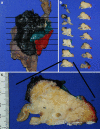The mesopancreas is the primary site for R1 resection in pancreatic head cancer: relevance for clinical trials
- PMID: 19418067
- PMCID: PMC2848727
- DOI: 10.1007/s00423-009-0494-8
The mesopancreas is the primary site for R1 resection in pancreatic head cancer: relevance for clinical trials
Abstract
Purpose: The prognosis of patients with pancreatic cancer remains poor, even after potentially curative R0 resection. This discrepancy may be due to the histopathological misclassification of R1 cases as curative resections (R0) in the past.
Materials and methods: To test this hypothesis, color coding of all resection margins and organ surfaces as part of a standardized histopathological workup was implemented and prospectively tested on 100 pancreatic head specimens.
Results: Thirty-five patients were excluded from the analysis owing to the pathohistological diagnosis; only pancreatic ductal adenocarcinoma, distal bile duct adenocarcinoma, and periampullary adenocarcinoma were included. Applying the International Union Against Cancer criteria, 32 cancer resections were classified R0 (49.2%), while 33 cases turned out to be R1 resections (50.8%). The mesopancreas was infiltrated in 22 of the 33 R1 resection specimens (66.6%). It proved to be the only site of tumor infiltration in 17 specimens (51.5%). Applying the Royal College of Pathologists' criteria, 46 resections were classified R1 (70.8%). As expected, the mesopancreas again was the most frequent site of noncurative resection (n = 27; 58.7%).
Conclusion: Using the intensified histopathological workup for pancreatic head cancer specimens resulted in an increased rate of R1 resections and the mesopancreas represents the primary site for positive resection margins. Such results are of relevance for patients' stratification in clinical trials.
Figures



References
-
- Fortner JG. Regional resection of cancer of the pancreas: a new surgical approach. Surgery. 1973;73:307–320. - PubMed
MeSH terms
LinkOut - more resources
Full Text Sources
Medical
Research Materials
Miscellaneous

